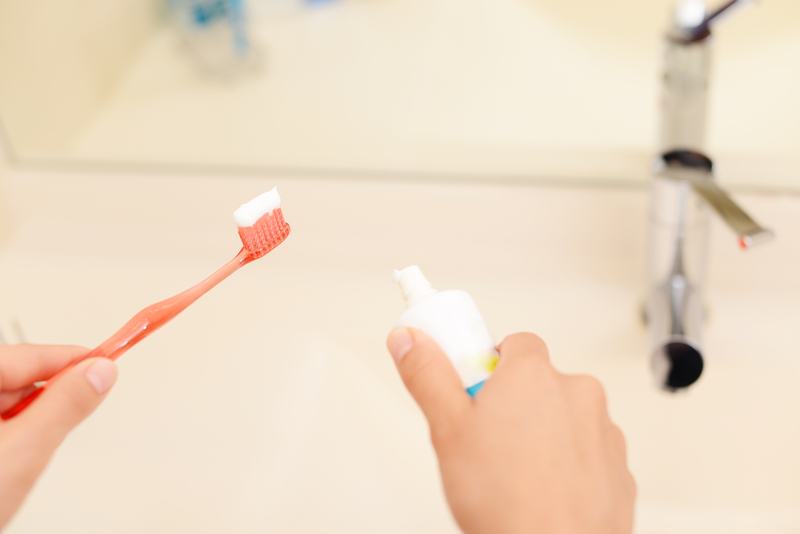What Is Hydroxyapatite? Does It Really Strengthen Teeth?

Strong, healthy teeth don’t just make your smile brighter. Oral health is a key indicator of your overall health. The usual recommendations are, of course, brushing and flossing your teeth regularly and consistently, often with fluoride. Yet a newer ingredient called hydroxyapatite is getting attention for repairing teeth. Is it time to reconsider traditional toothpaste? Let’s drill into hydroxyapatite benefits.
What Is Hydroxyapatite?
Your teeth are constantly going through a process of breaking down and building up or, more accurately, demineralizing and remineralizing. That is, after you eat, especially foods or drinks that contain sugars, the bacteria in the mouth create acids that break down the teeth. The body then repairs the teeth through the process of remineralization. To help shift the balance in your teeth’s favor, fluoride products have been used for decades.
Newer research, however, is revealing another teeth-strengthening compound called hydroxyapatite.
Hydroxyapatite is a naturally occurring mineral form of calcium apatite. It’s a key compound found in human bones and teeth. In fact, it makes up nearly 70% of bone and up to 90% of tooth enamel. It’s made up of calcium, phosphate, and hydroxide ions, which provide structural integrity and strength in the teeth and bones. Plus, it plays a vital role in the body’s metabolic processes for bone health and remodeling.
Because it’s biocompatible and has been shown to help promote bone growth, it’s now made its way into medical and dental applications where it’s used to make bone grafts and dental implants. It’s also used as a coating for metal implants to enhance their integration with bone tissue within the body.
For the purposes of this article, though, we’re most interested in hydroxyapatite benefits for teeth. This compound is now found in many kinds of toothpaste and dental care products.
The Process of Remineralization and Demineralization
Teeth naturally go through a process of dynamically demineralizing and remineralizing in response to the oral environment. For instance, saliva is rich in calcium, phosphate, and fluoride ions, which help neutralize the acids in the mouth, providing a favorable atmosphere for minerals to deposit on the enamel.
Dentists often recommend brushing or rinsing with fluoride products. This mineral plays a significant role in the remineralization process as it incorporates into enamel and helps form a more acid-resistance material on the teeth called fluorapatite. In addition, maintaining good oral hygiene (i.e., regularly brushing and flossing and regular trips to the dentist for checkups and cleanings) helps prevent plaque from producing.
This is important as plaque, along with bacteria that metabolize sugars and carbohydrates, increases the acids in the mouth that lower the pH and, in turn, demineralize teeth and dissolve calcium and phosphate ions from tooth enamel. Plaque is a sticky film of bacteria that accumulates on the teeth. And, if not removed, it can harden into tartar, which further promotes acid production and provides a rough surface that’s easier for plaque to accumulate on, making the issue worse.
Prolonged exposure to acids leads to the gradual loss of minerals in the surface enamel. The weakened enamel can then break down with microscopic pores, leading to the beginning of tooth decay.
Foods that provide calcium and phosphate, such as dairy products, provide the minerals needed for remineralization. Consuming sugary or acidic foods and beverages, on the other hand, increases the process of demineralization.
Other negative habits, such as smoking, drinking excessively, or some types of drug use, can also cause the enamel to erode, leading to increased demineralization and tooth decay. Signs of demineralization include tooth sensitivity. This is due to the loss of enamel, which exposes the underlying dentin. As demineralization continues, it can lead to the formation of cavities, which require treatment from your dentist. It can also lead to the accumulation of plaque and tartar, which can cause gum inflammation and potentially lead to gum disease.
By understanding the process and practicing good oral hygiene, you can maintain a positive balance of remineralization and demineralization to improve overall dental health.

Benefits of Hydroxyapatite for Teeth
Another step you can take to help promote remineralization is by using hydroxyapatite. You see, this novel compound has been found to safely and effectively help restore lost minerals in the enamel to promote stronger teeth. It has a similar composition to natural enamel, so it’s a safe option for dental treatments. And because it can integrate into the enamel structure, it can help fill in the microscopic gaps and potentially even repair early signs of tooth decay.
By reinforcing the enamel, hydroxyapatite also helps reduce the risk of cavities and creates a more resistant surface against acid attacks from bacteria and sugary foods and drinks. Some research also suggests hydroxyapatite benefits include making it harder for bacteria and plaque to stick to teeth. In addition, hydroxyapatite appears to help prevent sensitivity or discomfort from hot, cold, or sweet foods and drinks.
Finally, because hydroxyapatite helps smooth the surface enamel, it can lead to a brighter, whiter smile without the side effects found with typical teeth-bleaching agents.
To recap, hydroxyapatite has been found to help:
- Repair and restore enamel and reduce demineralization
- Reduce plaque formation as it’s harder for bacteria to adhere to the teeth
- Prevent cavities and tooth decay by reforming enamel and making it less susceptible to bacterial acid
- Reduce tooth sensitivity
- Smooth and brighten the enamel for a whiter and brighter smile (without the use of harsh bleaching agents)
In addition, hydroxyapatite is naturally biocompatible and nontoxic, so it’s safe for dental care products as it mimics the natural mineral composition found in teeth.
While hydroxyapatite has only recently entered the oral care market in the U.S., it has actually been used for over four decades and is often the preferred option in Japan. Interestingly, the ingredient was originally used by NASA astronauts in the 1970s after it was discovered that they lost minerals in their teeth and bones due to the lack of gravity found in space.
How Does Hydroxyapatite Compare with Fluoride?
Hydroxyapatite appears to be a safe and effective alternative to fluoride. The two ingredients work differently, yet hydroxyapatite seems to be as effective, if not more so, than fluoride in some dental care. For instance, one study found it was comparable or even superior when it came to remineralizing enamel lesions, preventing cavities, and reducing sensitivity. It’s also better for smoothing the enamel and improving the appearance of teeth. So, in addition to its protective effects, hydroxyapatite provides cosmetic benefits.
While fluoride has a long history of use and is widely proven to be effective in preventing tooth decay and cavities, and it’s generally considered safe, there are some concerns with its use. Some of the side effects include dental fluorosis due to excessive fluoride intake in developing teeth (i.e., in children under 8), which appears as white spots, streaks, pitting, or staining.
If large amounts of fluoride are swallowed, it can lead to toxicity, causing nausea, vomiting, diarrhea, abdominal pain, or more severe health issues. This is usually only a concern for young children who may swallow toothpaste when brushing. Hydroxyapatite is considered safer than fluoride if accidentally ingested.
The two ingredients also promote dental health in different ways and offer distinct benefits. Fluoride helps with the formation of fluorapatite, a more acid-resistant form of enamel, which promotes the incorporation of fluoride ions in the tooth structure. It also attracts calcium and phosphate ions to the tooth surface to aid in remineralization. Hydroxyapatite, on the other hand, directly replenishes the mineral content in enamel to help repair microscopic defects and strengthen the tooth surface.
In addition, fluoride inhibits the activity of cavity-causing bacteria, reducing acid production that can lead to tooth decay. In contrast, hydroxyapatite can block open dental tubules, which helps reduce tooth sensitivity.
Some people are also allergic to fluoride and experience irritation, rashes, respiratory issues, or other allergic reactions. And, long-term overexposure may also lead to skeletal fluorosis, which can affect the bones and joints. However, this side effect is generally only associated with excessive levels of fluoride exposure over years. It’s less common in areas where levels are controlled and limited (such as in drinking water, where fluoride has had a successful history of reducing the risk of cavities).
In contrast, hydroxyapatite is naturally biocompatible as it closely mimics the mineral composition of tooth enamel. It’s also safe for children and adults without the toxicity and adverse reactions associated with fluoride. So, parents of young children especially may feel more comfortable with hydroxyapatite toothpastes. You can also find toothpastes that contain both ingredients.
Hydroxyapatite does have some rare and mild side effects for some users. For example, some people may find mild, temporary irritation of the gums and oral lining. On rare occasions, people may experience redness, swelling, itching, or a rash with use, indicating an allergic reaction. (If this occurs, please stop using the product and reach out to your healthcare professional.) In a rare number of cases, some users have found increased tooth sensitivity when first using the product. However, this typically decreases as the enamel becomes stronger with continued use.
Finally, hydroxyapatite is marketed as natural or less chemically processed. Some people choose to use these products for personal or ethical reasons. It may also be more suitable for sensitive populations, such as young children and pregnant women, who are more cautious of the potential risks of overexposure to fluoride.
Both fluoride and hydroxyapatite have been found to protect against cavities and remineralize teeth. Hydroxyapatite is better at reducing sensitivity and whitening teeth. Fluoride is, however, more widely available and affordable. While both are generally considered safe, hydroxyapatite is nontoxic and biocompatible with minimal side effects. Fluoride can lead to toxicity if overconsumed.
Finally, both ingredients are found in a wide variety of dental products, including toothpaste and mouthwash, and are effective in promoting dental health. In addition, hydroxyapatite is used in professional treatments to repair enamel and coat implants. Fluoride, on the other hand, is added to many public water supplies to reduce tooth decay in the area’s population.
Choosing between the two depends on your personal preferences, health considerations, specific dental needs, and accessibility.
How to Use Hydroxyapatite
Many toothpastes now contain hydroxyapatite, especially micro or nano-hydroxyapatite (or nHAp), as an active ingredient to help with the remineralization process, reduce sensitivity, and whiten teeth. It can be used in addition to or instead of fluoride. Hydroxyapatite can also be found in mouthwashes and is again used to promote enamel repair. These products are designed to be used daily, and no significant adverse effects have been found with regular use. (Again, it has been used for decades.)
In addition, it’s found in some dental offices where it’s used for coatings on dental implants and fillings or to aid in the integration of implants and dental restorations as it improves longevity. Because of its versatility and effectiveness, it’s becoming a more valued ingredient for the promotion of oral health.
While the word “hydroxyapatite” doesn’t exactly roll off the tongue, a growing amount of science supports its use as an effective and safe ingredient to help improve dental health. Hydroxyapatite benefits range from remineralization to the reduction of sensitivity to whitening and brightening to overall enamel protection. As such, it’s become a valuable component in both everyday dental care and professional treatments.






